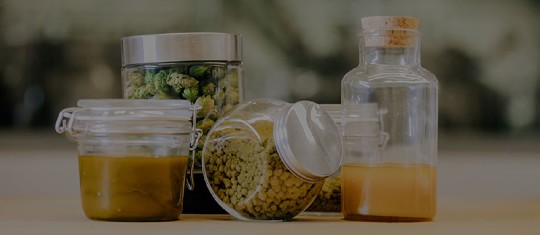Among brewers, there isn’t any other topic that is so controversially discussed as hop products: What are the differences between whole cone hops, pellets and extract? And which of them is more suitable?
In short: Each hop product is well suited for brewing beer, but each one has individual advantages and disadvantages. Therefore, it is up to every brewery to decide which product is best for them.
Although the main value-giving ingredients, i.e. hop oils and bitter substances, are present and unaltered in all three products, cones, pellets and extract do show differences in the yield of bitter substances – as shown in the following table:
| Whole cone hops | 15 - 20 % yield of bittering compounds |
| Normal Pellets | 25 - 35 % yield of bittering compounds |
| Enriched Pellets | 25 - 35 % yield of bittering compounds |
| CO2 Extract | 30 - 40 % yield of bittering compounds |
Advantages and disadvantages
WHOLE CONE HOPS
Harvested cones that are dried and packed in 60 kg (≈ 132 lbs) rectangular bales and then packaged, unprocessed, for use as soon as possible.
In whole cone hops the lupulin glands - which carry both the bitterness and the aroma of the hops - are well-hidden on the strig, under the bracts and bracteoles. These must first be broken open, resulting in a lower yield. In addition, the cones, which increase in size due to absorption of liquid during beer production, have to be removed again.
The advantage of using whole hop cones in brewing is that, apart from drying and packaging, they are not processed further and can be used immediately after harvesting. Since no processing takes place, the whole cone hops are also cheaper to purchase. However, the cones must be used quickly due to oxidation processes.
PELLETS
Milled and compacted hops, longer shelf life, higher density.
After milling, hops will have a larger contact surface area for beer. The lupulin glands will be partially broke open by the milling and pelletizing process, which will lead to a better dispersion in beer and therefore a better yield.
During the processing of whole cone hops to pellets, an additional process step of sifting can also be carried out to produce a pellet with higher oil and bitter acid concentrations, also known as enriched pellets. Since the aroma and bitter acids are only found in the lupulin glands and these have a diameter of 0.15 mm (0.06 inches), the lupulin glands can be separated (sieved) from the rest of the material. The hops are milled at approx. -35°C and because the glands are frozen, they can be easily separated. Two fractions are then created: the fine fraction (= lupulin-enriched powder) and a coarse fraction (everything else). These two fractions can, within the processed batch, be mixed and re-blended, thereby producing pellets with different alpha acid and oil contents. As enriched pellets contain less vegetative material, less product will later need to be removed from the wort/beer, thus reducing beer losses.
Because pellets are packed in inert gas, they have a considerably longer shelf life than hop cones, meaning their aroma stays stable for longer. Their increased density means less storage space is required for the same amount of product and because pellets are homogenized during production, variances in alpha acid and oil contents can be compensated. Nevertheless, pellets contain almost everything that hop cones also contain. (100kg whole cone hops will produce 90-95 kg pellets.)
EXTRACT
Extract of hops produced using gentle extraction methods to concentrate the most valuable hop compounds.
Extraction is defined as a dissolution of compounds from a solid substance into a solution. The solvent (in our case supercritical CO2) that is used serves only as a means of transportation. By using supercritical CO2, the hop resin and oil (but not the polyphenols) are extracted from the hop matrix. Once the process is completed, there is a pressure release (common extraction values are 300 bar or ~4350 psi!) and the CO2 will evaporate, causing the hop extract to separate out. This method provides a gentle way of concentrating valuable hop compounds using only physical processes.
Therefore, CO2 extract is the purest hop product, since it contains the highest concentration of valuable hop compounds (the bitter acids and oil compounds in the lupulin). CO2 extract is difficult to use on the cold side of the brewing process as the resin and oil do not dissolve well at low temperatures. When used in the brewhouse (on the hot side), however, it offers significantly higher yields than hop cones or pellets as there is no vegetative material and the hop compounds are more readily available.
Differences in taste?
Another important question we are always asked is whether differences in taste can occur depending on whether extract or pellets are used.
When comparing at the hop products, one thing is clear: The more the hops have been processed, the purer the most valuable compounds are. However, there is also a progressive removal of polyphenol.
Polyphenols are partly responsible for a good mouthfeel when the hops are added midway through the wort boil. Low-molecular polyphenols even have a pleasant bitterness, whereas higher-molecular polyphenols tend to have a harsh or astringent bitterness. Beware: polyphenols form complexes with proteins, which lead to poorer haze stability.
TASTE TEST: PELLETS VS. EXTRACT
We brewed two beers that were identical except for the hop product. One beer was dosed with pellets and the other one with Herkules CO2 extract. Both beers had an original gravity of 13% and were fermented with a dry ale yeast from Fermentis.
In internal panels and also at the Braukunst Live! (craft beer festival in Munich), 92 people tried the beers in a triangle test. Here are the results:
- Of the 92 participants, 77% could correctly identify the different sample.
- Of these 77% correct answers, 60% preferred the beer dosed with CO2 extract.
These results indicate a taste advantage of the CO2 extract.
Reasons why the beer with the CO2 extract was preferred:
- Stronger, more pleasant aroma
- Less astringency
- Pleasant bitterness
- Better drinkability due to “lighter” taste
If you have any questions for our taste experts contact us at brewingsolutions@barthhaas.de.


